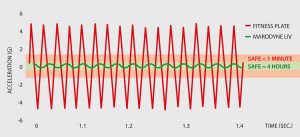What makes Marodyne LiV so safe?
The difference between individual devices and different levels of vibration (in relation to frequency, amplitude, acceleration, training on alternating sides or vertical stimuli) essentially lies in the mode of operation, the technical design and in the safety offered by the vibration treatment.
First of all: why is Marodyne LiV so accessible?
The treatment is gentle and safe because the stimuli are small and easily tolerated. The patented Marodyne LiV treatment system is the only medically certified vibration platform in the world that generates stimuli of 0.4 g constantly at 30 Hz and an amplitude of between 0.05 mm and 0.2 mm. In comparison with the more aggressive vibration plates (which you might have seen at a fitness centre), treatment using Marodyne LiV feels like the purring of a contented cat. The stimuli are controlled by a microprocessor and automatically adjust to suit each user. You do not need to set anything and can use the treatment easily and conveniently at home.
Whole Body Vibration (WBV) and Low Intensity Vibration (LiV)
When we talk about safety, we primarily mean the effectiveness and reliability of the treatment – but we also mean the absence of risk. The risk during vibration training can be avoided if you choose the right device.
The aspects of effectiveness, reliability and risk describe the key difference between Whole Body Vibration (WBV) which provide a high amplitude vibration, primarily targeting muscle and designed for fit and health people to improve their performance and fitness and the more modern, gentle biomechanical Low Intensity Vibration (LiV) offered by Marodyne designed for therapeutic use to treat disease.
The highly forceful vibration platforms do have justification, even if the medical results are not always documented. They bring enjoyment in sport and fitness, strengthening of the muscles and challenging physical training – if you can take it. Muscle training with these Whole Body Vibration (WBV) devices has traditionally been offered to young athletes in fitness centres and is popular among fit, healthy groups. But it carries risks for elderly, infirm or sick people. From middle age onwards, medical professionals and therapists advise gentler vibrations for maintaining and building up muscles, bones, vitality and especially with osteoporosis.
The difference: the force per stimulus
The difference between Whole Body Vibration (WBV) and Low Intensity Vibration (LiV) is in the so-called level of vibration. This is typically interpreted as a function of force (g-force), frequency (Hz) and length of use (time). One ‘g’ is equivalent to the gravitational field of the earth or acceleration of 9.81 metres per second squared. And ‘g’ is therefore also a figure for acceleration which it is quoted as a multiple of acceleration due to gravity. The frequency is the number of stimuli per second.
High intensity devices (Whole Body Vibration – WBV) are the ones that deliver a higher force than 1 g (per stimulus), irrespective of frequency.
Consider this example of how WBV would affect your body. If you weigh 70 kg and are standing on a device for vibration training at 4 g – then about (4 x 70kg =) 280 kg is applied to your skeleton, four times your body weight. At 6 g, it is as much as six times, around 420 kg.
And this is with every single pulse of vibration.
These figures should give you food for thought… especially if you are older, feel weak or have osteoporosis.
Why Low Intensity Vibration?
Whole Body Vibration (WBV) should be assigned to sports training and approached with great caution while Low Intensity Vibration (LiV) should be offered as a therapeutic treatment to help people who are elderly, weak, living with osteoporosis or seeking a gentle way to boost their circulation.
Low Intensity Vibration can be fully justified as it has been shown through plentiful studies and extensive research to be safe and effective. Scientific evidence and clinical studies of LiV show that the low intensity, mechanical signals maintain the mobility of joints and assist the build-up of muscles and bone substance. There is an additional treatment option in its effect against the new formation of fat cells in obesity and with pain.
Whole Body Vibration (WBV) carries a high risk and before starting any form of vibration training, it is important to consider which type of vibration should be applied to the body. It must be understood that not all vibration devices are the same and in terms of vibration ‘more’ or ‘stronger’ is not necessarily better. In fact it represents a real risk to many people.
By comparison, the low intensity vibration signal provided by Marodyne LiV is categorised as safe for daily use at a threshold level of up to 4 hours in relation to the human vibration tolerance by the International Organization for Standardization (ISO). See graph ISO 2631 (cf. also » ISO 2631 Mechanical vibration and shock — Evaluation of human exposure to whole-body vibration).

ISO 2631 describes sensible load values and the length of use in relation to the human organism: this standard and other similar ones have been developed for fields such as aircraft construction and motors for vibrating machinery and therefore also apply to devices for vibration training. Platforms such as those that can be found in some fitness centres in the area for building muscle can reach dangerously high load values, which are equivalent to many times the user’s body weight. Marodyne LiV on the other hand works at around 40% of the user’s weight or 0.4 g – and the output is automatically regulated, measured and controlled in the process.
Vibration training – where are the risks?
It is important to emphasise that Low Intensity Vibration (LiV) treatment is categorised as safe. Other frequencies and vibrations, such as those that can be generated in Whole Body Vibration (WBV), can cause damage to bones and connective tissues. WBV training is categorised by leading medical professionals as risky and has shown it can be dangerous under certain circumstances to the musculoskeletal system (for example, to intervertebral discs, cartilage, ligaments and tendons) as well as possibly causing damage to the vestibular system (affecting the organ of balance) and the cardiovascular system (affecting circulation).
For many people, their experience of vibration training is forceful shaking of their body which they find uncomfortable and stressful. For some their session causes nausea, headaches and muscle pain – especially if they are older or already have problems with their bones, muscles or balance. These reactions are felt quickly. Later on, any tissue damage that occurs is detected later, as in the case of an examination finding micro-fractures in the bones.
No-one should underestimate the power of mechanical stimulation in the form of vibration training. A little targeted stimulation can benefit your health but you can have too much of a ‘good thing’. Put it this way, one aspirin a day can do you good but you’d never take 50 a day or believe more is better!
There are a lot of devices for vibration training on the market that use the benefits of whole body vibration in their advertising. These devices supply high magnitude signals of considerably more than 8 g – way beyond the level recommended for physical tolerance by the ISO (International Safety Organisation) and OSHA (Occupational Safety and Health Administration). As well as having higher frequency signals, these devices usually have higher amplitude too – sometimes 30-40 times stronger than the low intensity signals that LiV uses.
Vibration treatment with LiV is safe
In contrast to the misgivings concerning vibration training that uses more than 1 g (WBV), it should absolutely be pointed out that LiV uses just 0.4 g and no adverse effects have been observed in anyone, in any of the numerous research studies that have been undertaken. We are especially proud of this fact and hope it brings you the same reassurance that it gives to us.
